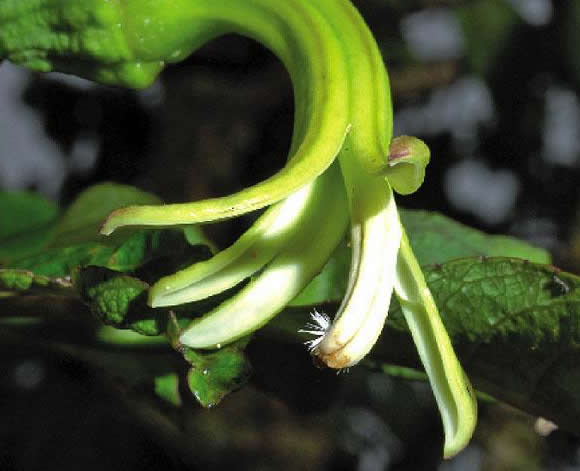Hawai‘i: Extinct is forever (but not for this lobelia)
06.09.10
A Hawaiian plant, presumed extinct for 90 years, and whose Hawaiin name commemorates Pele (the volcano goddess in Hawaiian mythology), has rather appropriately been discovered on the slopes of the Kohala volcano.
Scientists from The Nature Conservancy made the discovery earlier this summer in an upland rainforest on the slopes of Kohala volcano on Hawai‘i Island. “We were surveying a rare tree snail population when we came across a native lobelia plant that we were unable to identify,” said Jon Giffin, the Conservancy’s Hawai‘i Island field representative.
 The lobelia (Clermontia) was found growing on ‘ōhi‘a (the myrtle Metrosideros polymorpha) and hapu‘u (the tree fern Cibotium menziesii) and photographs of the plant were rapidly sent to Dr. Thomas Lammers, a Clermontia authority, at the University of Wisconsin Oshkosh, who identified it as Clermontia peleana ssp. singuliflora.
The lobelia (Clermontia) was found growing on ‘ōhi‘a (the myrtle Metrosideros polymorpha) and hapu‘u (the tree fern Cibotium menziesii) and photographs of the plant were rapidly sent to Dr. Thomas Lammers, a Clermontia authority, at the University of Wisconsin Oshkosh, who identified it as Clermontia peleana ssp. singuliflora.
C. peleana singuliflora © Rob Shallenberger
“C. peleana singuliflora was last seen on the Island of Hawai‘i in 1909 and last collected on East Maui in 1920,” Giffin said. “It was presumed extinct prior to the rediscovery.” When told of the find the land manager for Parker Ranch (the land owners), gave the Conservancy permission to search for other individuals and collect seeds for propagation. Over 30 individual plants have been found, many of which were flowering and fruiting. Seeds from seven different plants have been taken to the Volcano Rare Plant Facility for propagation.
C.peleana singuliflora is one of two subspecies of Clermontia peleana (in Hawaiian: ‘oha wai), an epiphytic shrub or tree. Until now, C. peleana singuliflora has never been reported from the Kohala region. Over 30 individuals have been found, many of which were flowering and fruiting, and seeds from seven different plants have been taken to the Volcano Rare Plant Facility for propagation.
“It will be another two or three months before we know if they germinate,” said Giffin. “But we plan to collect more seeds in the future.”
Dr. Sam Gon, senior scientist and cultural advisor for The Nature Conservancy of Hawai‘i, called news of the find heartening but not surprising. “In a place like Hawai‘i, with its rich native diversity, rugged terrain and remote places, there is always the potential for new and exciting discoveries,” he said.
Related links:
Italy: Endangered sedge is treated to a new home
31.08.10
 An endangered sedge, found in Europe in only two sites in southern Italy, has benefitted from a multi-faceted conservation project carried out by Rome Botanical Garden, the Italian Institute for Environmental Protection and Research (ISPRA) and the Regional Body for Protected Areas (RomaNatura).
An endangered sedge, found in Europe in only two sites in southern Italy, has benefitted from a multi-faceted conservation project carried out by Rome Botanical Garden, the Italian Institute for Environmental Protection and Research (ISPRA) and the Regional Body for Protected Areas (RomaNatura).
UK: First centaury sighting in half a century
27.08.10
![]() The perennial centaury (Centaurium scilloides), last seen in England in the 1960s, has been re-discovered growing on coastal cliffs in Cornwall. Its only other known UK habitat is the coastal paths of Pembrokeshire National Park, Wales.
The perennial centaury (Centaurium scilloides), last seen in England in the 1960s, has been re-discovered growing on coastal cliffs in Cornwall. Its only other known UK habitat is the coastal paths of Pembrokeshire National Park, Wales.
Ascension Island: Hooker’s lost parsley fern found on mountain
17.08.10 by Stedson Stroud and Olivia Renshaw
On 27 July, 2009, the Ascension Island Government’s Conservation Team were conducting a routine annual plant census with botanist Dr. Phil Lambdon. “We were exploring a narrow ridge on the southern side of Green Mountain. By chance, Phil and I noticed a tiny frond sticking out of a crevice in the rock." Stedson Stroud and Olivia Renshaw tell the story of their chance discovery.
UK: Rare buttercup found in Shropshire field
08.07.10
 Botanists in Shropshire were delighted last week when they discovered Ranunculus arvensis growing at Pimhill Farm. The plant hasn't been recorded for 50 years and was believed to be extinct in the county.
Botanists in Shropshire were delighted last week when they discovered Ranunculus arvensis growing at Pimhill Farm. The plant hasn't been recorded for 50 years and was believed to be extinct in the county.